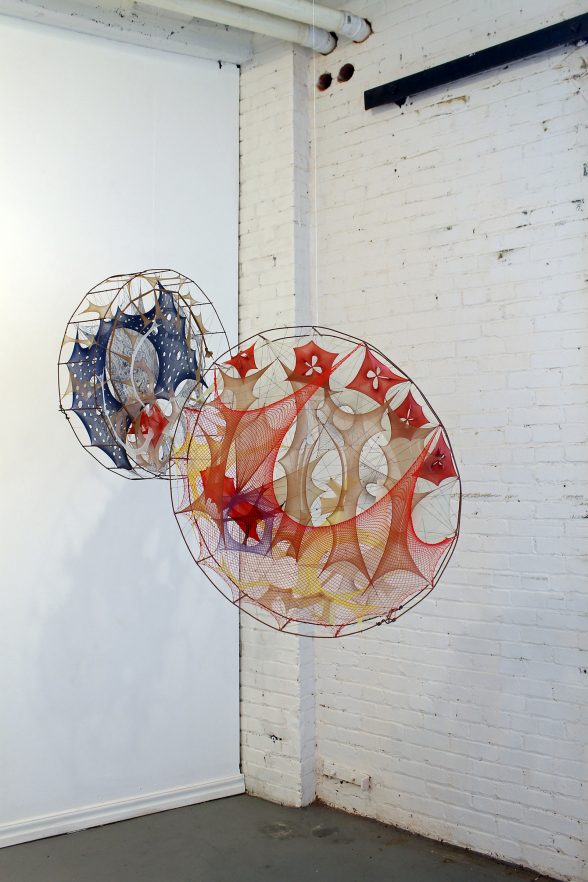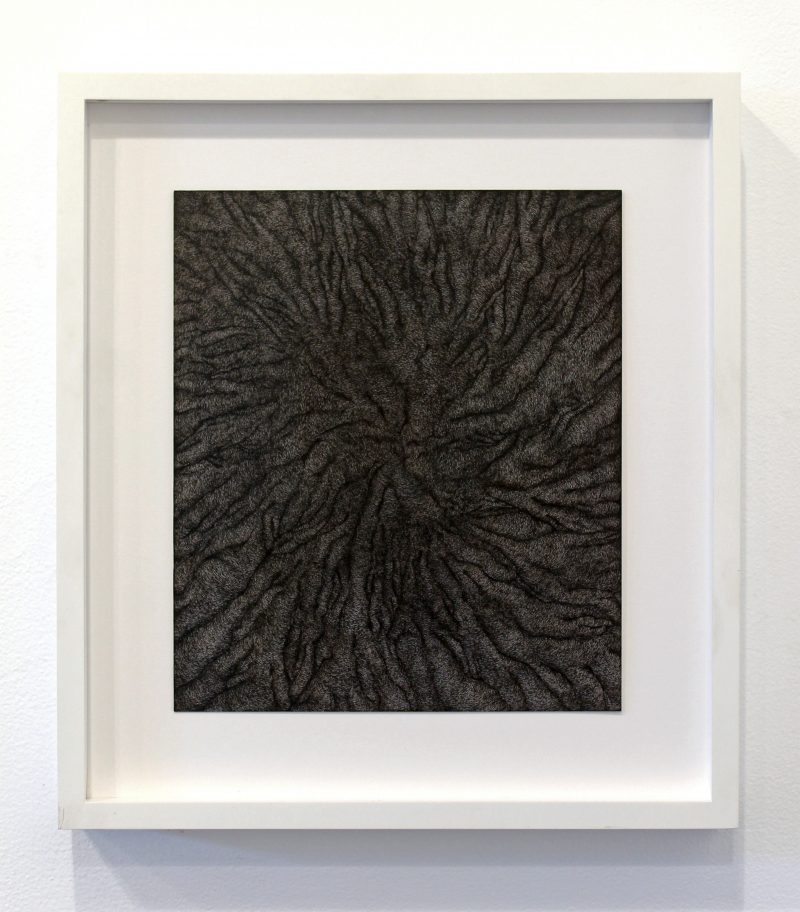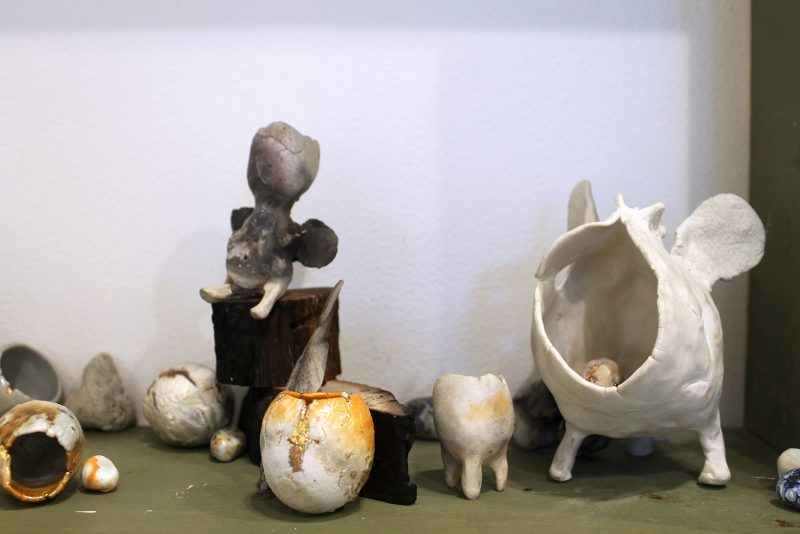If there is one factor that fuels a vast and disparate portion of creative work, it is pattern. From musical rhythms to visual motifs, the pattern-recognition of the human brain primes all of us, regardless of our other proclivities, to value and produce work that stands firmly on a foundation of repetition. At Spillway Collective’s current exhibit “We Do What We Do,” all of the creations on display involve some type of repetitive process. Each personal approach and choice of medium by the eighteen artists featured may be viewed as a standalone work that depends on the accretion of its parts: dots, lines, letters, and strands of fabric, just to name a few. Similarly, the inclusion of these self-contained pieces within the same space provides a glimpse into the nature of order and arrangement, without which, human imagination would be all but adrift.
Although some of those participating are traditionally trained artists, a large majority of the featured artists are not. For this show, curator Shannon Rose Moriarty set out to connect with the Center for Creative Works in Wynnewood, whose mission is to provide resources for artists with intellectual disabilities. By highlighting untrained, natural talents beside the work of professional Philadelphia-area artists, the perceived barriers between these two segments of the creative population are demolished so as to view the works in the context of methods alone.

In a show that is mostly still, the only physical movement at Spillway comes by way of Katie Truk’s gently spinning pair of hanging mobile-like sculptures, “Screwed” and “Impaled.” Woven onto wheel-shaped, wire armatures, Truk attaches scraps of pantyhose and stockings along multiple planes in order to construct contained patterns which are reminiscent of three-dimensional Spirograph drawings.
As the neighboring structures rotate close together, the interplay of the planned contours, along with the native weaves and textures of the fabrics, creates a continually shifting geometric spectacle within each independent piece, but also when viewed together, one through the other. Truk’s compositions focus on the slippery midpoint that lies between conscious artistic preparation and randomness. Even when pattern is fastidiously calculated, chance often finds ways to sneak in and surprise us, sometimes interrupting a considered motif or aligning two apparently separate elements.
Steven Frisoli’s two untitled contributions to the show involve multicolored markers and overlapped handwriting of sorts. Frisoli’s precise words are difficult or impossible to discern (if they are truly words at all), but their meaning seems to take a back seat to their placement. The mere impression of text forces our brains to attempt to start reading, much like the psychological phenomenon of pareidolia causes us to perceive faces or images in clouds, rocks, or other places where no such depictions exist. Whether or not the runic marks constitute any meaning beyond their layout is unclear, but the truly important consideration here is how the marks work together: as vivid cascades of deeply layered strokes of the artist’s hand.

Regarding the artist’s hand, as well as a sense of movement, Astrid Bowlby’s “Untitled (for Grendel and Johnny” engages both. Through a thick haze of meticulously inked hatching, Bowlbly produces depth and direction using only a chorus of thin, black pen strokes. Bowlby’s hand, however, is mostly hidden unless the viewer moves in very closely to make out the specific linework. The effect is that the cumulative direction of the marks naturally draws in the viewer’s gaze toward the very center of the work, like a vortex. The revelation here, of course, is that although there is no real motion, the fixed lines can still usher our eyes around the page, and land them right where the artist intends — the illusion of movement consequently generating actual ocular responses on the part of the audience.
For Cindy Gosselin, who is blind, tactile techniques are by far the most vital part of the creative process. Upon seeing the intricately wound, yarn-swaddled objects at the center of the gallery, it drastically changes our perceptions to understand how these rocky-yet-plush sculptures are made. Gosselin’s system of pattern-making lies outside the visible realm where most artists operate, as she feels and wraps her way to a finished product.
In a world where popular culture and art communicate increasingly with a shared visual language of signs, symbols and images, it is important to recognize those who cannot participate directly in this exchange, and also to temper our skewed awareness with other ways of understanding.

Many other artists in this exhibition have fascinating work as well, such as B. Monser, who fills a found shelf with various organic objects and little creatures which have been dutifully hollowed out into delicate vessels. Tammy Byerly’s “Cute Shapes and Words” provides an assortment of colorful polygons that explore the many different, yet astoundingly similar shapes the artist can concoct as variations on a theme.
Regardless of who we are or where we come from, our instincts as tool-building primates will invariably pull us toward some semblance of organization, even when the rest of the universe topples away into chaos and constant expansion. “We Do What We Do” at Spillway Collective unveils eighteen unique directions these artists take as they travel on this journey to organize, manipulate, and make sense of our environment.
Others exhibiting at Spillway this month are: Jessica Eldredge, Cassie Flanagan, Clyde Henry, Laurie Hughes, Jason McGonigle, Joyce Moseley, Faith Rowbottom, Karlee Salamone, Kristina Salamone, Brandon Spicer-Crawley, Tamisha Williams, and Ivia Sky Yavelow.
“We Do What We Do” will be on view through September 9. Spillway Collective is located inside the Crane Arts building at 1400 N. American Street, Philadelphia.









